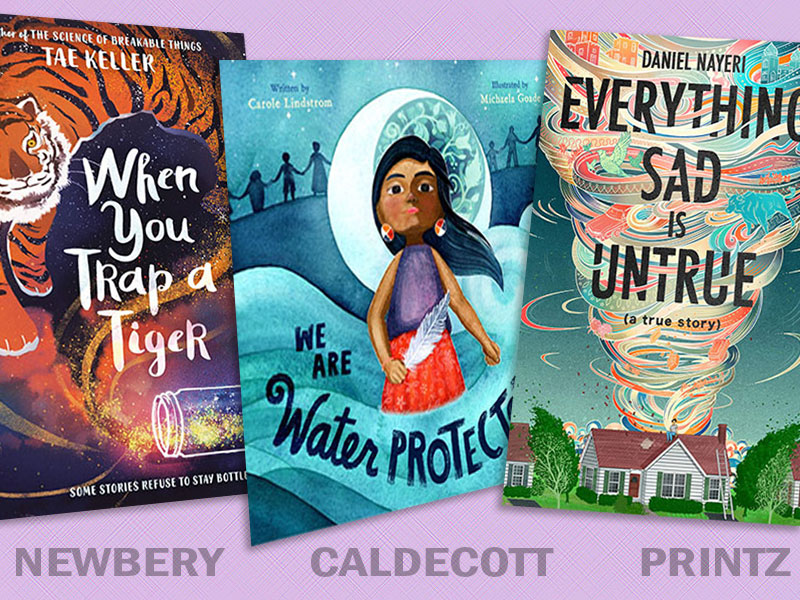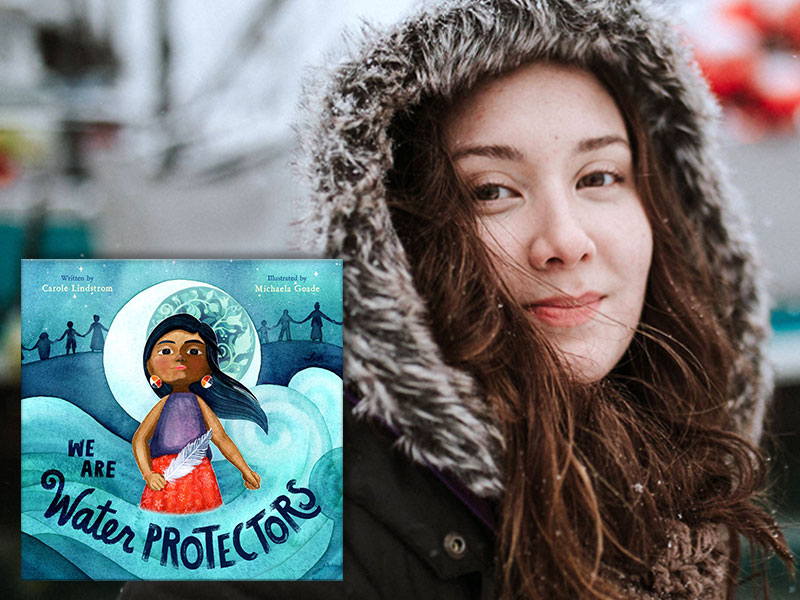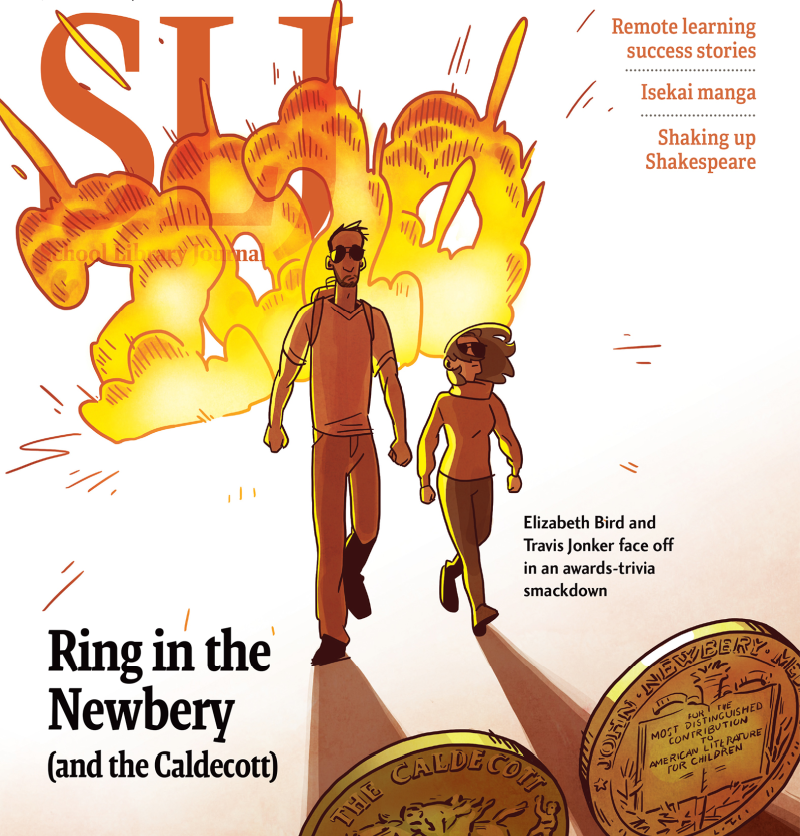Heavy Medal Mock Newbery Finalist: THE BEATRYCE PROPHECY by Kate DiCamillo
THE BEATRYCE PROPHECY

Introduction by Heavy Medal Award Committee member Aryssa Damron
THE BEATRYCE PROPHECY charms readers with its illustrated manuscript style, a mysterious young protagonist, and an ornery goat, and feels almost grown in a lab to be another Newbery contender for two-time Medalist Kate DiCamillo.
Beatryce, our titular character driving this novel set in the medieval period, is found sick and dirty by Brother Erik, who quickly takes to the young girl. So too does the ornery, aggressive goat Answelica, which is a good thing for Beatryce, who must be hidden at the monastery during her recovery, for she is hunted by the king. As Erik works on his own illustrated manuscript, Beatryce begins to tell stories of her own, stories that reveal a fate greater than either of them ever could have expected when she was found snuggling with a goat.
ADVERTISEMENT
ADVERTISEMENT
This story-loving story feels familiar in a warm, inviting way. It will remind long-time Newbery winners of THE MIDWIFE’S APPRENTICE by Karen Cushman and CRISPIN: CROSS OF LEAD by Avi, but of course has DiCamillo’s signature wit, humor, and a protagonist you’ll root for. By the end of the tale, readers will be tearing up at the power of words and reminded of why DiCamillo already has two Newbery Medals.
Sophie Blackall’s illustrations do an excellent job of supporting the tone of the novel—bringing the illustrated manuscript style into the 21st century with care and impressive detail, but without making it untenable to young readers. Coupled together, this book feels like a gift, something to be treasured and re-read, even more so than DiCamillo’s other books. The writing is a sort of rhythmic meditation that feels rooted in its time period and almost mesmerizing to the modern reader.
In the dim barn, it was hard to gauge subtleties of emotion, particularly in the eyes of a being who had seldom before evidenced subtleties of any sort, but Brother Edik thought he recognized the flicker in the goat’s eye.
p 15
Beatryce, caught in her fever, captured by her dream, turned from side to side, working to escape.
p 20
While this title is an obvious contender–based on the overall themes and DiCamillo’s background–it might be hard to convince a committee of broad readers to give her a third Medal. If so, she would be the first person in the century of Newbery medalists to be a three-time winner. Even so, the book seems perfectly situated for its audience–not too complicated, but interwoven enough to intrigue the older end of the Newbery spectrum. DiCamillo weaves a strong moment in history with almost magical moments and stories within stories.
This is a book that will continue to resonate with readers for years to come, and provide great conversation to librarians and readers alike.
Heavy Medal Award Committee members and others are now invited to discuss this book further in the Comments section below. Please start with positive observations first; stick to positives until at least three comments have been posted or we reach 1:00 pm EST. Let the Mock Newbery discussion begin!:
Filed under: Book Discussion, Heavy Medal Mock
About Steven Engelfried
Steven Engelfried retired from full-time library work a couple years ago and now works as a part-time Youth Librarian at the West Linn Public Library in Oregon. He served on the 2010 Newbery committee, chaired the 2013 Newbery Committee, and also served on the 2002 Caldecott committee. You can reach him at sengelfried@yahoo.com.
ADVERTISEMENT
ADVERTISEMENT
SLJ Blog Network
Should I make it holographic? Let’s make it holographic: a JUST ONE WAVE preorder gift for you
Press Release Fun: Happy Inaugural We Need Diverse Books Day!
Halfway There: A Graphic Memoir of Self Discovery | Review
When Book Bans are a Form of Discrimination, What is the Path to Justice?
RA Tool of the Week: Inside Out Inspired Emotions, but Make it YA Books
ADVERTISEMENT








This was, obviously, one of my most anticipated books of this year, especially thinking about Newbery Contenders. I think Di Camillo weaves a magical story and is just getting better and better with time—thinking about this in conversation with Tale of Despereaux, even, is interesting. It feel more…sophisticated? Not in a bad way, just in an observable difference
Aryssa, I completely agree with you about one of the most anticipated books of the year. This was just an outstanding book. Kate DiCamillo does it again. The characters and the storyline were just fabulous. The fantasy aspect as well as the insinuations towards the real world right now in regards to kindness, courage, feminism, learning, and believing in oneself. All great themes for children. I think this magical book is indeed worthy of another award.
I love her ending
“It could be that this book, the book of Beatryce, is the story of the world yet to come. Who can say? One thing that is certain, though: what matters in the end is not prophecies. …
What does, then, change the world? …Love… Love, and also stories.”
YES! Need I say more. Bravo to Kate DiCamillo, such an extraordinary author.
This one feels fantasy to me, even thought there is no magic—though Answelica is very nearly a talking animal character!—so I’ve enjoyed describing this one to my students as a fairy tale. Imagined medieval setting, powerful transformation that upsets the royal order. Another strength in this story is its humor: Answelica’s demonic behavior provides levity in an otherwise quite serious tale.
I’ve been thinking about the setting a lot, and like how Emily says “imagined medieval setting,” there’s no set historical time period// specific setting and I think that’s interesting and it does work, but would the setting be stronger is it was more specific?
As a “lay reader”, I found the setting not quite strong – it vacillated between medieval and fairy tale, I thought, and sometimes the fairy tale elements undercut the setting (particularly the ending).
I think it lives most strongly in DiCamillo’s incredible, resonant writing and not on its own, as a delineated medieval place.
Emily comments that this “feels fantasy to me, even though there is no magic,” and that’s really true. . Along those same lines, I would add that it feels lighthearted, but it’s also very serious. War and death and oppression loom over the whole story, with friendship and courage and knowledge prevailing in the end. But the reading experience still had an element of playfulness neatly mixed in…
And who can argue with that theme- the power of literacy! I agree that this story felt like fantasy with the unusual characters and overall mood. Her writing is always fluid and warm. I saw this author talk about how this story came to be when she spoke at the Teachers College Reunion this fall and her description even had that magical quality to it. Kids seem to really connect with her characters so I am interested to see how they react to this one. It seems like a great choice for a teacher read aloud!
Definitely a stellar read-aloud!
Indeed! I am reading it to sixth graders as they eat lunch right now. A student came up afterward on the first day I started reading it to them and said, “Wow, that writing is really good. Who is the author again?” I said, “Kate DiCamillo–or I just call her Kate the Great.”
There were definitely a lot of things that I liked about this book, particularly exploring the themes of literacy, love of others and yourself, and knowledge. I do think this book will resonate with many young readers who love adventures and fantasy. And of course Answelica is an icon. I think my other opinions about this book are kind of controversial-I felt that the characters were a bit flat. Beatryce felt a little too perfect for me, and at the end, I felt that I knew next to nothing about Cannoc. The relationship between Jack Dory, Beatryce, and Cannoc and how quickly they developed love for each other seemed a little too sudden. The plot seemed to wrap up a little too quickly too with the mother suddenly being alive, and then found, and then Cannoc is the king, and the mother is ruling along beside him. I get that DiCamillo is trying to get the fairytale vibe where characters are slightly more one-dimensional, and this was a short book, so you don’t have all the time in the world for character development. I just wish it was a little bit more. Obviously, it’s still a very good book and the illustrations are outstanding, and I think it’s a great fit in any classroom.
I think I’m with you on this Megan, I loved the story and it was a fun read, but it did not stick with me at all. I also had to read the ending at least three times to fully understand it- and I think it all wrapped together too easily. The beginning was really strong and I admired the development but then it crashed for me.
Megan points out “the fairytale vibe where characters are slightly more one-dimensional.” That is a typical characteristic of fairytales. I felt something similar with David Elliott’s THE SEVENTH RAVEN…that one’s based on a specific folktale, and though I thought the style was excellent, there was a distance between reader and story. I think DiCamillo allays some of that with the goat, who seems to be the most memorable character, and has specific qualities that you don’t expect in a folktale animal. But maybe a bit more is needed with the younger audience?
I agree with others that this book really felt like a fantasy. Perhaps it’s because so much of what is written about this time period is written as fantasy? So many aspects were reminiscent of adventure fantasies I’ve read in the past.
The characters are truly lovable, especially my favorite, Answelica. I mean who doesn’t love an ornery goat with a great judge of character?
I know that previous winning stance plays no part in how the award is decided, but I do feel as if there are so many other wonderful contenders that the committee may take this into account. The book is wonderful, but I’m not sure if it merits a greatest contribution to children’s literature this year. I don’t mean to compare it to other works, but my favorite book that seems similar to this is The Book of Boy.
Absolutely, Amanda! The Book of Boy had a fairy tale vibe, but is a much stronger foray into this genre. And the characters in the Book of Boy live on with me years later whereas, as others have mentioned, those in this one felt rather flat and I’ve managed to forget them all (except for the wonderful Answelica) just a few months after reading.
I loved THe Beatryce Prophecy so very much, particularly how, as others have stated, the sadness is well-leavened with gentle humor. THe stories-within-a-story framework is excellently done, showing how Beatryce’s own predicament is mirrored by the stories she tells and eventually writes.
I hate to level any complaint about this beautifully written story, but I did feel that the climactic scene was rushed. As the main villain is so divious throughout the book and has some very memorable scenes, I just couldn’t understand why he didn’t put up a fight of any sort. It just felt a bit too easily resolved. I do love the fairy tale feel, though. I just think the evil aspect should be more of a challenge for the protagonists.
I second Meredith’s comment: the king and the advisor were so easily disposed of that it kind of detracted from the accomplishment of Beatryce and company.
I wonder if that is what is most properly medieval about the setting: how small the world is. One town, one castle, very limited impact. Beatryce walks everywhere. One solder remembers the king, who has not gone very far.
The one soldier remembering the king was one of the more frustrating parts for me. It seemed like there should be some kind of test or a better explanation of how the king was recognized. Other parts of the plot fit together neatly, so it felt really off.
I really enjoyed this book and it’s fairytale-like setting. I definitely think it excels most thematically. The themes are very clear throughout the book (education and literacy). And I do think the author intended it to have a fairy tale or allegory vibe but in doing so I do think it made both the setting and the characters flatter since they were almost meant to be “every person” and “anywhere”.
I also felt when I initially finished this book, that, while I really enjoyed the reading experience and I would be excited to share this with a child reader, the theme was very heavy-handed. You could not have missed the point if you tried and I do feel like that detracts a bit from the book for me.
I enjoyed reading THE BEATRYCE PROPHECY, DiCamillo’s biggest strength to me is her storytelling ability, and how she uses a distinct assortment of characters to tell her story: Brother Edik with his wayward eye, Jack Dory with his talent of mimicry, Beatryce who carries hope in her heart, and especially Answelica, the spunky goat who is a great judge of character. I would have like to see more character development of Beatryce’s mother and Cannoc, the wayward king, as they seem integral to the story.
As others have stated, I too thought the end of the story was rushed. As Meredith stated the king and the counselor didn’t even put up a fight. I guess I wanted to see a confrontation, and as Steven stated the king and advisors were disposed of so easily that it detracted from
the accomplishments of Beatryce and company.
Another concern I have is about the themes presented. Were the main themes trying to show the power of literacy, the importance of telling stories to enrich our lives, or the importance of friendship and love in your life, being true to yourself, evil versus good, or was this book trying to show female empowerment or evils of classism? All of these are wonderful themes, but I personally thought too many ideas were presented.
Even though I had some concerns, I did loved reading this book, as DiCamillo is a master storyteller, uses distinct assortments of characters, and I loved her stories within a story.
I enjoyed this book but didn’t feel that it rose to the level of distinguished. Perhaps DiCamillo has just set too high a bar for herself. I think Aryssa’s phrase “feels like it was grown in a lab” really hits the nail on the head–everything wrapped up too neatly and it didn’t feel original enough to me.
One of my “mock” participants, the youngest, came up with a wordless description for the moment you feel like you have read a Newbery winner. Miss Ella used her hands to demonstrate that “aha” moment when your mind is blown. It’s indescribable, but anyone who has a fondness for children’s and young adult literature experiences that same moment when you truly believe you are holding something special and find words inadequate. Maybe that’s why it’s so hard to define “distinguished.” For me, I have been known to pat my books lovingly when booktalking them, and The Beatryce Prophecy was lovingly caressed!
I agree with those who look at this book as a fairy tale. Because of this, I did not mind characters who are not fully developed. They are given enough attributes for me to care about each of them, including Answelica! I was routing for each of them! The major characters do show strength and growth. Brother Edik finds his voice and value in himself. Beatryce, over time, becomes less a victim and more of a courageous heroine. And Jack Dory exchanges revenge and retribution for love and learning. Cannoc and the remaining characters are not as important, but mere devices used to move the plot along.
The themes are timeless and timely. I saw The Beatryce Prophecy as a story about power. What is power? Father Caddis is powerful but is rendered powerless by the ruling king. The King is so wrapped up in holding onto his power that he is willing to kill for it. The counselor revels in his own perception of who is really in power. Cannoc walks away from power. Jack, Edik and Beatryce become more powerful as they let go of the “stories” that have power over them. Even Answelica wields her own kind of power over the humans who try to unsuccessfully to dominate her.
Continuing on the thread of power is the power of stories, both in the telling and the writing. The “Chronicles of Sorrowing” and their prophecies hold great power over the fate of a kingdom. Beatryce is able to escape her trauma through the mermaid’s story. Edik is given the gift of story through Beatryce’s tale of the mermaid. Even the commoners are forbidden to read and write, because both give them power – something the ruling class needs to contain.
I was completely invested in this plot-driven story. It felt special from the endpapers and design choices to the illustrations and the story with its stories within. Kate DiCamillio has given young readers a timeless, deceptively simple yet rich fairy tale with much to consider. I strongly defend this title as a Newbery contender.
I love your student’s description of the feeling you get when you are holding that special book that rises to the top. For me it’s more of an electrical tingle from my scalp all the way down to my fingertips. Ironically, I distinctly remember feeling it while reading Flora and Ulysses all those years ago. I did feel that thrill while reading Beatryce and a few other contenders this year. I think it’s important to remind ourselves and our students that the thrill of finding that uniquely special, transcendent book is ours to keep–whether or not the ALA committee decision elevates our book. Too often we look at the Newbery Medal announcement as a pronouncement of truth from an infallible jury. That magical tingle (wherever we feel it–arms? fingertips? toes?) matters the most in the long run because that book will remain with us and become a part of us–whether it is selected by the committee or not. I hope that all readers–the young and the young at heart–find tingles of transcendency when reading. And maybe–hopefully? the ALA committee will feel tingles from the same books. Maybe Beatryce?
Thank you for this, Molly. We all have different things that make us tingle!
I’m going to be That Person and say that while I enjoyed this book, the frequent mentions of maple sugar candy took me right out of the story. Maple sugar is from North America, discovered and developed by the indigenous people there. Europeans didn’t have access to it until the colonial era. So it was a weird anachronism for me. Yes, yes — it’s “historical fantasy,” but that seems like a cop-out, like enjoying the trappings and feel of historical fiction without the painstaking research and detail-oriented work of historical fiction. And saying it’s a “fantasy” also seems like a stretch, when there really isn’t much of a supernatural element to the story at all. Love me that Jack Dory, though.
This made me think a lot, so thank you for that. There were some elements that took me out of THE BEATRYCE PROPHECY, but this actually wasn’t one of them. Two books that came to mind when thinking about this were AUNTIE PO and A PLACE TO HANG THE MOON. In the latter book, a very specifically English matter served as inspiration for yet another American’s book. A PLACE TO HANG THE MOON was admirable in its combination of stylistic mimicry and modern mores, but as it was historical fiction, there was of course no attempt to “make it one’s own” from the author’s specifically American perspective. AUNTIE PO is also historical fiction but taps into American folklore. There, of course, claiming and adapting that lore into the character’s culture is very much the point. (Personally, even though that was the point, it actually took me out of AUNTIE PO more than the candy of BEATRYCE, but that has more to do with execution than intent.) So my thinking is: of course American writers draw freely from a folklore heritage (fairy tales, Camelot, Narnia, etc.) that is actually not American at all. To me, regarding DiCamillo, a writer of great specificity and also a very specifically American author—maple sugar candy feels a little like AUNTIE PO—an expression from the author’s origin in a tale whose origin isn’t hers, and is thus made a little more her own. Paul Bunyan doesn’t have to be white, and maybe it’s OK for there to be a candy just because (I imagine) it has a specific sensory significance for DiCamillo. (That said; I am in no way suggesting any of this was necessarily conscious on DiCamillo’s part, unlike AUNTIE PO, and I prefer it that way.)
Hmmm… I’m struggling with our collective assumption that this book is set in a time/place that could (or should?) be aligned with some part of history. Why? Because there are monks who illuminate manuscripts? Because there is a king? Could this not just as easily be about a time and place that only exist in the imagination? Perhaps the reason we feel that it has elements of fantasy or magic is because it isn’t meant to be historical fiction?
Take these questions with a HUGE grain of salt as I am only about 50 pages into this one. I’m also terribly late to catch up with the last few posts, so I understand if no response is available!